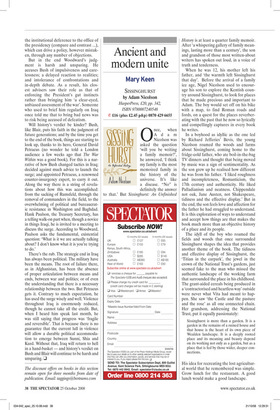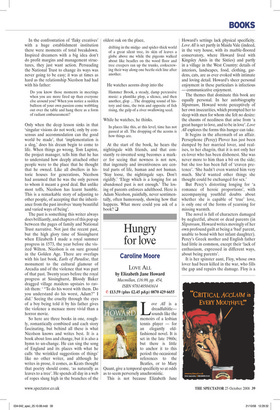Ancient and modern unite
Mary Keen
SISSINGHURST by Adam Nicolson HarperPress, £20, pp. 342, ISBN 9780007240548 ✆ £16 (plus £2.45 p&p) 0870 429 6655 Once, when A d a m Nicolson was asked the question ‘will you be writing a family memoir?’, he answered, ‘I think my family is the most memoired family in the history of the universe. It’s like a disease. “No” is definitely the answer to that.' But Sissinghurst: An Unfinished History is at least a quarter family memoir. After ‘a whispering gallery of family meanings, lasting more than a century’, the son and grandson of those most written-about writers has spoken out loud, in a voice of truth and tenderness.
When he was 12, his mother left his father, and ‘the warmth left Sissinghurst that day’. Before the arrival of a family ice age, Nigel Nicolson used to encourage his son to explore the Kentish country around Sissinghurst, to look for places that he made precious and important to Adam. The boy would set off on his bike with a map, to find Roman roads and fords, on a quest for the places reverberating with the past that he now so lyrically and compellingly captures in every book he writes.
In a boyhood as idyllic as the one led by Richard Jefferies’ Bevis, the young Nicolson roamed the woods and farms about Sissinghurst, coming home to the fridge-cold father, who ate boil-in-the-bag TV dinners and thought that being moved by music was a sign of sentimentality. As the son grew up he realised how different he was from his father. ‘I liked roughness and incompleteness, Romanticism, the 17th century and authenticity. He liked 44 P Palladianism and neatness. Chippendale not oak, Jane Austen, not Shakespeare, tidiness and the effective display.’ But in the end, the son feels love and affection for the father he had struggled to understand. It is this exploration of ways to understand and accept how things are that makes the book much more than an objective history of a place and its people.
The idyll of the boy who roamed the fields and woods that once surrounded Sissinghurst shapes the idea that provides another theme of the book. The tidiness and effective display of Sissinghurst, the ‘Titian in the carpark’, the jewel in the crown of the National Trust’s gardens, just seemed fake to the man who missed the authentic landscape of the working farm that surrounded the place in his childhood. The grant-aided cereals being produced in a ‘contractorised and heartless way’ outside were never what Vita had meant to happen. She saw ‘the Castle and the pasture and the rose’ as all one connected chain. Her grandson, addressing the National Trust, put it equally passionately:
Sissinghurst is more than a garden. It is a garden in the remains of a ruined house and that house is the heart of its own piece of Wealden landscape. It is a deeply rooted place and its meaning and beauty depend on its working not only as a garden, but as a place that is fed by those wider, deeper connections.
His idea for recreating the lost agricultural world that he remembered was simple. Grow lunch for the restaurant. A good lunch would make a good landscape. In the confrontation of ‘flaky creatives’ with a huge establishment institution there were moments of total breakdown. Inspired dreamers with a big idea don’t do profit margins and management structures, they just want action. Persuading the National Trust to change its ways was never going to be easy; it was at times as hard as the relationship Nicolson had had with his father:
Do you know those moments in meetings when you are more fired up than everyone else around you? When you notice a sudden balloon of your own passion come wobbling out over the table and hang there as a form of radiant embarassment?
Only when the deep lesson sinks in that ‘singular visions do not work; only by consensus and accommodation can the good world be made’, that ‘implementation is a slog,’ does his dream begin to come to life. When things go wrong, Tom Lupton, the project manager, tells him that he has to understand how deeply attached other people were to the place that he thought that he owned. Like all dwellers in historic houses for generations, Nicolson had assumed that he was the only person to whom it meant a good deal. But unlike most toffs, Nicolson has learnt humble. This is a remarkable story of adjusting to other people, of accepting that the inheritance from the past involves ‘many beautiful and varied ways of being’.
The past is something this writer always does brilliantly, and chapters of this pop up between the pages of family and National Trust narrative. Not just the recent past, but the high glory time of Sissinghurst when Elizabeth I made a royal summer progress in 1573, the year before she visited Wilton. Nicolson is on sure ground in the Golden Age. There are overlaps with his last book, Earls of Paradise, that monument to the cultural glamour of Arcadia and of the violence that was part of that past. Twenty years before the royal progress at Sissinghurst, Bloody Baker dragged village maidens upstairs to ravish them: ‘ “To do his worst with them. Do you understand do his worst, Adam?” I did.’ Seeing the cruelty through the eyes of a boy being told it by his father gives the violence a menace more vivid than a horror movie.
So here are three books in one, roughly, romantically combined and each story fascinating, but behind all these is what Nicolson knows and writes best. It is a book about loss and change, but it is also a hymn to un-change. He can sing the song of England and its places with what he calls ‘the wrinkled suggestions of things’ like no other writer, and although he writes in prose, it comes, as Keats thought that poetry should come, ‘as naturally as leaves to a tree’. He spends all day in a web of ropes slung high in the branches of the oldest oak on the place,
drifting in the midgeand spider-thick world of a great silent tree, its skin of leaves a globe above me while the pigeons walked about like beadles on the wood floor and tree creepers ran up the trunks, corkscrewing their way along one beetle-rich line after another.
He watches acorns drop into the
Hammer Brook, a steady, damp percussive music: a plumlike plop, a silence, and then another, glop ...The dropping sound of history and time, the twin and opposite of fish rising, the gulp of a river swallowing seed.
While he watches, he thinks.
In places like this, at this level, time has not passed at all. The dropping of the acorns is how things are.
At the start of the book, he hears the nightingale with friends, and that constantly re-invented song becomes a marker for seeing that newness is not new, that ingenuity and inventiveness are central parts of life, human and not human. ‘Stay loose, the nightingale says. Don’t rigidify.’ ‘Elegy which is a longing for an abandoned past is not enough.’ The losing of parents enforces adulthood. Here is Adam Nicolson, painfully, never sentimentally, often humorously, showing how that happens. What more could you ask of a book? q



















































































 Previous page
Previous page